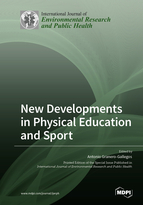New Developments in Physical Education and Sport
A special issue of International Journal of Environmental Research and Public Health (ISSN 1660-4601). This special issue belongs to the section "Global Health".
Deadline for manuscript submissions: closed (30 September 2020) | Viewed by 130965
Special Issue Editor
Interests: sport; physical education; body image; motivation; teaching; psychometric properties; validation
Special Issues, Collections and Topics in MDPI journals
Special Issue Information
Dear Colleagues,
The improvement of teaching processes and the different variables that affect learning are a continuing concern among the different agents involved in teaching. This Special Issue aims to collect the most recent research regarding the social aspects of the physical education classroom, such as the teaching style and motivational classroom climates. It will also cover their influence and relationship on different psychological aspects of students and the relationship with physical activity behaviors outside the classroom. On the other hand, in this Special Issue, the research regarding different aspects of the promotion of moderate and vigorous physical activity of students, inside and outside the school, as well as for the creation of healthy and permanent physical exercise habits are also important. The analysis of the physical education classroom and the practical proposal for improvements, both in the classroom and its impact on leisure time, is a clear objective of this Special Issue. In this sense, it is intended to make a special impact on innovation and pedagogical models. It is related to physical education teachers from different stages and educational contexts and how they are incorporating them into the teaching-learning process due to the results reported in relation to different variables (e.g. motivation, autonomy, classroom climate, social and interpersonal relationships, etc.). In the same way, in this Special Issue it will also be included the research that reflects this proposal but in the context of sports learning.
A quality physical and sports education based on scientific evidence of an empirical nature should be offered to the society. That is why systematic review articles and meta-analysis will be welcome in this Special Issue.
Prof. Antonio Granero-Gallegos
Guest Editor
Manuscript Submission Information
Manuscripts should be submitted online at www.mdpi.com by registering and logging in to this website. Once you are registered, click here to go to the submission form. Manuscripts can be submitted until the deadline. All submissions that pass pre-check are peer-reviewed. Accepted papers will be published continuously in the journal (as soon as accepted) and will be listed together on the special issue website. Research articles, review articles as well as short communications are invited. For planned papers, a title and short abstract (about 100 words) can be sent to the Editorial Office for announcement on this website.
Submitted manuscripts should not have been published previously, nor be under consideration for publication elsewhere (except conference proceedings papers). All manuscripts are thoroughly refereed through a single-blind peer-review process. A guide for authors and other relevant information for submission of manuscripts is available on the Instructions for Authors page. International Journal of Environmental Research and Public Health is an international peer-reviewed open access monthly journal published by MDPI.
Please visit the Instructions for Authors page before submitting a manuscript. The Article Processing Charge (APC) for publication in this open access journal is 2500 CHF (Swiss Francs). Submitted papers should be well formatted and use good English. Authors may use MDPI's English editing service prior to publication or during author revisions.
Keywords
- teaching
- physical education
- physical activity and sport
- motivation
- moderate and vigorous physical activity
- classroom and extracurricular physical activities
- health education






